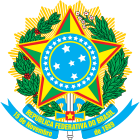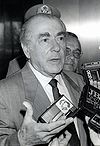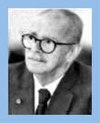1994 Brazilian general election
| ||||||||||||||||||||||||||||||||||||||||||||||||||||||||||||||||||||||||||||||||||||||||||||||||
|
| ||||||||||||||||||||||||||||||||||||||||||||||||||||||||||||||||||||||||||||||||||||||||||||||||
Presidential election | ||||||||||||||||||||||||||||||||||||||||||||||||||||||||||||||||||||||||||||||||||||||||||||||||
| Turnout | 82.24% | |||||||||||||||||||||||||||||||||||||||||||||||||||||||||||||||||||||||||||||||||||||||||||||||
|---|---|---|---|---|---|---|---|---|---|---|---|---|---|---|---|---|---|---|---|---|---|---|---|---|---|---|---|---|---|---|---|---|---|---|---|---|---|---|---|---|---|---|---|---|---|---|---|---|---|---|---|---|---|---|---|---|---|---|---|---|---|---|---|---|---|---|---|---|---|---|---|---|---|---|---|---|---|---|---|---|---|---|---|---|---|---|---|---|---|---|---|---|---|---|---|---|
| ||||||||||||||||||||||||||||||||||||||||||||||||||||||||||||||||||||||||||||||||||||||||||||||||
 Election by states, shaded accounding to vote share | ||||||||||||||||||||||||||||||||||||||||||||||||||||||||||||||||||||||||||||||||||||||||||||||||
| ||||||||||||||||||||||||||||||||||||||||||||||||||||||||||||||||||||||||||||||||||||||||||||||||
513 seats in the Chamber of Deputies 257 seats needed for a majority | ||||||||||||||||||||||||||||||||||||||||||||||||||||||||||||||||||||||||||||||||||||||||||||||||
This lists parties that won seats. See the complete results below. | ||||||||||||||||||||||||||||||||||||||||||||||||||||||||||||||||||||||||||||||||||||||||||||||||
| This article is part of a series on the |
 |
|---|
General elections were held in
Elected in
On election day, Cardoso received 54 percent of the vote, negating the need for a second round. He defeated Lula by over 27 points, still a record margin for a presidential election held under democratic conditions. Cardoso notably won every state in the
Background
In 1989, Brazil held its first direct presidential election since 1960 following the end of the military dictatorship in Brazil. Fernando Collor, a young, charismatic leader who had previous served as Governor of Alagoas, won a hotly contested election versus Luiz Inácio Lula da Silva after positioning himself as a political outsider.[13][14] Just over two years into his presidency, Collor was faced with allegations of corruption by his brother Pedro Collor, and chose to resign in late 1992 rather than face certain conviction and removal in an impeachment trial.[15][16]
Following his resignation,
Franco was barred from running for a full term in 1994. In Brazil, whenever a vice president serves part of a president's term, even when the president travels abroad, it counts as a full term. At the time, the Constitution did not allow a president to run for immediate reelection. In the absence of Franco, Cardoso would be chosen by the PSDB (a party born from inside the PMDB) as their nominee for President of Brazil in the 1994 election.
Lula's running mate controversy
As he had in 1989, Lula intended for Senator José Paulo Bisol of Rio Grande do Sul, a member of the Brazilian Socialist Party (PSB), to serve as his vice presidential running mate. A former judge, Bisol had a strong reputation as an opponent of corruption,[20] playing a key role in the investigation that ultimately led to President Fernando Collor de Mello's resignation. Additionally, his membership of a party that played a crucial role in the centre-left coalition made his selection attractive to Lula.[21] Bisol's image as a "Mr. Clean" was harmed during campaign season by revelations of wrongdoing as a judge in 1981.[22]
The saga proved damaging to Lula's campaign, and as a result the leadership of the PT looked for a replacement for Bisol on the ticket. Arguing that Bisol should be replaced on the ticket by a fellow member of the PSB, PSB president Miguel Arraes pushed for the selection of Célio de Castro, then serving as Vice Mayor of Belo Horizonte, to replace Bisol as Lula's running mate.[23] Key power-players in the PT, such as party president Rui Falcão, successfully convinced Lula to replace Bisol with Aloizio Mercadante. A co-founder of the PT, Mercadante was then serving as a federal deputy for São Paulo.[24] Mercadante's background as a career economist during a hyperinflation crisis was seen as a plus for PT party leadership.[25]
Campaign of Enéas Carneiro
In the
In 1994, Carneiro mounted a second bid for the presidency. The entrance of
Considered a
Candidates
Candidacies denied
| Party | Candidate | Most relevant political office or occupation | Party | Running mate | Coalition | Electoral number | ||
|---|---|---|---|---|---|---|---|---|
|
Liberal Party (PL) |
 Flávio Rocha |
Member of the Chamber of Deputies from Rio Grande do Norte (1987–1995) |
Liberal Party (PL) |
Jadihel Lohedo Júnior |
— | 22 | ||
|
Labour Party of Brazil (PTdoB) |
Caetano Matanó Júnior. |
Labour Party of Brazil (PTdoB) |
Rafael Francisco | — | 70 | |||
Results
President
| Candidate | Running mate | Party | Votes | % | |
|---|---|---|---|---|---|
| Fernando Henrique Cardoso | Marco Maciel (PFL) | Brazilian Social Democracy Party | 34,364,961 | 54.28 | |
| Luiz Inácio Lula da Silva | Aloizio Mercadante | Workers' Party | 17,122,127 | 27.04 | |
| Enéas Carneiro | Roberto Gama | Party of the Reconstruction of the National Order | 4,671,457 | 7.38 | |
| Orestes Quércia | Iris de Araújo | Brazilian Democratic Movement Party | 2,772,121 | 4.38 | |
| Leonel Brizola | Darcy Ribeiro | Democratic Labour Party | 2,015,836 | 3.18 | |
| Esperidião Amin | Gardênia Gonçalves | Reform Progressive Party | 1,739,894 | 2.75 | |
| Carlos Antônio Gomes | Dilton Carlos Salomoni | National Reconstruction Party | 387,738 | 0.61 | |
| Hernani Fortuna | Vitor Nósseis | Social Christian Party | 238,197 | 0.38 | |
| Total | 63,312,331 | 100.00 | |||
| Valid votes | 63,312,331 | 81.22 | |||
| Invalid/blank votes | 14,636,133 | 18.78 | |||
| Total votes | 77,948,464 | 100.00 | |||
| Registered voters/turnout | 94,782,803 | 82.24 | |||
| Source: TSE | |||||
Chamber of Deputies
Party of National Mobilization 257,018 | 0.56 | 4 | +3 | | |||||
|---|---|---|---|---|---|---|---|---|---|
| Popular Socialist Party | 256,485 | 0.56 | 2 | New | |||||
| Social Christian Party | 213,734 | 0.47 | 3 | –3 | |||||
| Progressive Republican Party | 207,307 | 0.45 | 1 | +1 | |||||
| National Reconstruction Party | 184,727 | 0.40 | 1 | –39 | |||||
| Green Party | 154,666 | 0.34 | 1 | New | |||||
| Brazilian Communist Party | 0 | –3 | |||||||
| Brazilian Renewal Labour Party | 0 | New | |||||||
| United Socialist Workers' Party | 0 | New | |||||||
| Labour Party of Brazil | 39 | 0.00 | 0 | 0 | |||||
| Total | 45,694,172 | 100.00 | 513 | +10 | |||||
| Valid votes | 45,694,172 | 58.84 | |||||||
| Invalid/blank votes | 31,966,623 | 41.16 | |||||||
| Total votes | 77,660,795 | 100.00 | |||||||
| Registered voters/turnout | 94,743,043 | 81.97 | |||||||
Senate
| Party | Votes | % | Seats | |
|---|---|---|---|---|
Party of National Mobilization | 486,430 | 0.51 | 0 | |
| Total | 95,813,507 | 100.00 | 54 | |
| Total votes | 77,949,111 | – | ||
| Registered voters/turnout | 94,743,043 | 82.27 | ||
| Source: Nohlen | ||||
Notes
References
- ^ ISSN 0362-4331. Retrieved 2 December 2020.
- ^ Almanaque Abril, 28ª ed, 1995
- ^ SAYAD, João. Observações sobre o Plano Real. Est. Econ. São Paulo. Vol. 25, Nº Especial, págs. 7-24, 1995-6
- ^ "Brazil's new Embraer 70-seat jet rivals small Boeing, Airbus planes". Waterloo Region Record. 30 October 2001. p. C8. Retrieved 8 March 2011.
- ^ "Lula's legacy for Brazil's next president". BBC News. 2010-09-30. Retrieved 2020-12-02.
- ^ "Folha de S.Paulo - PT quer Mercadante para o lugar de Bisol - 27/7/1994". www1.folha.uol.com.br. Retrieved 2020-12-02.
- ^ "Folha de S.Paulo - PT quer Mercadante para o lugar de Bisol - 27/7/1994". www1.folha.uol.com.br. Retrieved 2020-12-02.
- ^ "'Depois da cadeia, Lula dificilmente voltará à política', diz vice da chapa do petista em 89 e 94". BBC News Brasil (in Brazilian Portuguese). Retrieved 2020-12-02.
- ^ a b "Eleição presidencial: o Plano Real na sucessão de Itamar Franco".[permanent dead link]
- ISSN 0362-4331. Retrieved 2020-12-02.
- ^ Lapper, Richard (2018-07-03). "It's Lula Forever in Brazil's Northeast". Americas Quarterly. Retrieved 2020-12-02.
- ^ "O retorno de Enéas, ícone da extrema-direita e 'herói' de Bolsonaro". BBC News Brasil (in Brazilian Portuguese). Retrieved 2020-12-02.
- ^ "A guerra ao turbante". Abril. Veja.com. 23 March 1988. Archived from the original on 17 March 2009. Retrieved 24 July 2012.
No seu papel de caçador de marajás, o alagoano Fernando Collor de Mello torna-se um dos governadores mais populares do país
- ISSN 0362-4331. Retrieved 2020-12-01.
- ^ Rezende, Tatiana Matos. "UNE 70 Anos: "Fora Collor: o grito da juventude cara-pintada"". União Nacional dos Estudantes. Archived from the original on September 3, 2007. Retrieved August 9, 2009.
- ISSN 0362-4331. Retrieved 2020-12-02.
- ^ "President Itamar Franco - 1992-1994". www.globalsecurity.org. Retrieved 2020-12-02.
- ISSN 0362-4331. Retrieved 2020-12-02.
- ISSN 0013-0613. Retrieved 2020-12-02.
- ^ "Brazilian corruption commission under pressure". UPI. Retrieved 2020-12-02.
- ^ "Folha de S.Paulo - Lula quer ter Bisol como vice na chapa - 30/4/1994". www1.folha.uol.com.br. Retrieved 2020-12-02.
- ^ "Politics: Brazil's Leading Candidate Loses Momentum : Presidential hopeful Luiz Inacio Lula da Silva fights to avoid a runoff. His image is threatened by a scandal surrounding his choice of running mate". Los Angeles Times. 1994-07-15. Retrieved 2020-12-02.
- ^ "Folha de S.Paulo - PT quer Mercadante para o lugar de Bisol - 27/7/1994". www1.folha.uol.com.br. Retrieved 2020-12-02.
- ^ "Resist Newsletter, Sept. 1994 - Core" (PDF).
- ^ "Folha de S.Paulo - PT quer Mercadante para o lugar de Bisol - 27/7/1994". www1.folha.uol.com.br. Retrieved 2020-12-02.
- ISSN 0099-9660. Retrieved 2020-12-02.
- ^ ""Meu nome é Enéas": lenda da extrema-direita influenciou Bolsonaro, diz Le Monde". noticias.uol.com.br (in Brazilian Portuguese). Retrieved 2020-12-02.
- ^ "Folha de S.Paulo - Enéas não é Enéas - 30/9/1994". www1.folha.uol.com.br. Retrieved 2020-12-02.
- ^ "Como preocupação com interesse estrangeiro levou militares a criar reserva extinta por Temer". BBC News Brasil (in Brazilian Portuguese). Retrieved 2020-12-02.
- ^ Wille, José (October 2020). "O folclórico Enéas queria ser presidente em 1994 | Portal Memória Brasileira" (in Brazilian Portuguese). Retrieved 2020-12-02.
- ISSN 0362-4331. Retrieved 2020-12-02.
- ^ "Leonel Brizola, 82; Brazilian Politician". Los Angeles Times. 2004-06-23. Retrieved 2020-12-02.

















